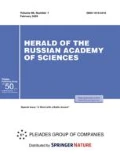Abstract
The problem of chemophobia is caused by an increasing chemical load on the environment on the one hand and an insufficient level of chemical literacy among the population on the other hand. This paper prepared from the materials of a report presented at the Scientific Session of the General Meeting of the RAS on November 14, 2019, presents the data of sociological studies providing insight into the attitude to chemistry in different countries. Green chemistry may become an efficient tool for overcoming chemophobia and agrochemophobia as a variant of it. It is not a new earlier unknown trend. It is rather a compact formulation of thinking principles for well-trained and socially responsible chemists–scientists or technologists. The latter thesis is confirmed by the active practical application of green chemistry approaches in industry including in Russia. However, not only the business community, but also top-level politicians have begun to try to follow this way of thinking. The United Nations has pointed out that green chemistry is a key science development trend.


Similar content being viewed by others
REFERENCES
D. I. Mendeleyev, “Correlation of properties with the atomic weight of elements, Zh. Russ. Khim. Obshch., No. 1, 6077 (1869).
C. N. Waters, J. Zalasiewicz, C. Summerhayes, et al., “The Anthropocene is functionally and stratigraphically distinct from the Holocene,” Science 351 (6269), 137 (2016).
W. Steffen, J. Grinevald, P. Crutzen, and J. McNeill, “The Anthropocene: Conceptual and historical perspectives,” Philos. Trans. R. Soc. A: Math., Phys., and Eng. Sci. 369 (1938), 842–867 (2011).
J. Rockström, W. Steffen, K. Noone, et al., “Planetary boundaries: Exploring the safe operating space for humanity,” Ecol. Soc. 14 (2) (2009). http://www.ecologyandsociety.org/vol14/iss2/art32/.
J. Rockström, W. Steffen, K. Noone, et al., “A safe operating space for humanity,” Nature 461, 472–475 (2009).
N. P. Tarasova and A. S. Makarova, “Assessment of the chemical pollution in the context of the planetary boundaries,” Russ. Chem. Bull. 65, 1383–1394 (2016).
UNEP/EA.4/21. United Nations Environment Assembly of the United Nations Environment Program, Nairobi, March 11–15, 2019. https://undocs.org/UNEP/EA.4/21.
The Public Health Impact of Chemicals: Knowns and Unknowns: Data Addendum for 2016 (World Health Organization, 2018). http://www.who.int/ipcs/publications/chemicals-public-health-impact/en/.
N. J. Moreau, “Public images of chemistry,” Chem. Int. 27 (4), 6–9 (2005).
J. Edwards, C. Ceci, and E. Ratcliffe, “What the public really thinks about chemistry,” Chem. Int. 38 (3–4), 16–19 (2016).
M. Gnad, “MP tries to ban water,” New Zealand Herald, Sep. 14 (2007). https://www.nzherald.co.nz/nz/news/article.cfm?c_id=1&objectid=10463579.
Local officials nearly fall for H2O hoax. http://www.nbcnews.com/id/4534017/ns/technology_and_science-science/t/local-officials-nearly-fall-ho-hoax/.
https://web.archive.org/web/20130529114948/http://old.sosiaalinenvaalikone.com/kysymykset.php?id=12894.
M. Smith, D. C. Love, C. M. Rochman, and R. A. Neff, “Microplastics in seafood and the implications for human health,” Curr. Environ. Health Rep. 5 (3), 375–386 (2018).
R. J. K. Helmes, M. A. J. Huijbregts, A. D. Henderson, and O. Jolliet, “Spatially explicit fate factors of phosphorous emissions to freshwater at the global scale,” Int. J. Life Cycle Assess. 17, 646–654 (2012).
N. P. Tarasova, A. S. Makarova, E. G. Vasileva, and D. D. Savelova, “Estimation of the phosphorus loading with consideration for the planetary boundaries (for the Russian Federation as an example),” Pure Appl. Chem. 89, 287–292 (2017).
N. P. Tarasova, A. S. Makarova, E. G. Vasil’eva, et al., “Assessment of the phosphorus load on fresh water bodies of the constituent entities of the Russian Federation: Modeling the migration of phosphorus and its compounds between environmental components,” Dokl. Akad. Nauk 480 (6), 717–721 (2018).
Report of the Open Working Group of the General Assembly on Sustainable Development Goals, A/68/970. https://undocs.org/A/68/970.
P. Tundo, P. Anastas, and D. StC. Black, et al., “Synthetic pathways and processes in green chemistry: Introductory overview,” Pure Appl. Chem. 72 (7), 1207–1228 (2000).
N. P. Tarasova, O. M. Nefedov, and V. V. Lunin, “Chemistry and problems of sustainable development and protection of the environment,” Russ. Chem. Rev. 79 (6), 439–440 (2010).
“Pike Research: Green chemistry: biobased chemicals, renewable feedstocks, green polymers, less-toxic alternative chemical formulations, and the foundations of a sustainable chemical industry,” Ind. Biotechnol. 7 (6), 431–433 (2011).
N. P. Tarasova, A. S. Makarova, S. Yu. Vavilov, S. N. Var-lamova, and M. Yu. Shchukina, “Green chemistry and Russian industry,” Herald Russ. Acad. Sci. 83 (6), 499–505 (2013).
A. S. Makarova, J. Xuexiu, E. B. Kruchina, et al., “Environmental performance assessment of the chemical industries involved in the Responsible Care® program: Case study of the Russian Federation,” J. Cleaner Prod. 222, 971–985 (2019).
Author information
Authors and Affiliations
Corresponding authors
Additional information
Translated by E. Glushachenkova
RAS Corresponding Member Natalia Pavlovna Tarasova is Chairholder of the UNESCO Chair in Green Chemistry for Sustainable Development, Mendeleev University of Chemical Technology of Russia. Anna Sergeevna Makarova, Dr. Sci. (Eng.), is an Associate Professor of the UNESCO Chair in Green Chemistry for Sustainable Development, Mendeleev University of Chemical Technology of Russia.
Rights and permissions
About this article
Cite this article
Tarasova, N.P., Makarova, A.S. Green Chemistry and Chemophobia. Her. Russ. Acad. Sci. 90, 245–250 (2020). https://doi.org/10.1134/S1019331620020161
Received:
Revised:
Accepted:
Published:
Issue Date:
DOI: https://doi.org/10.1134/S1019331620020161



